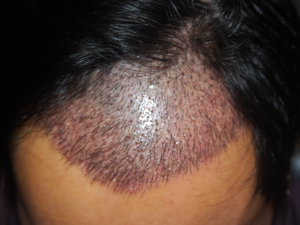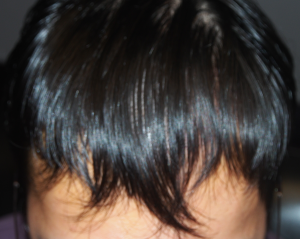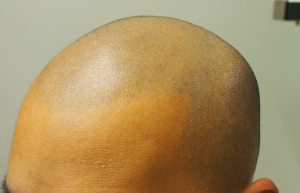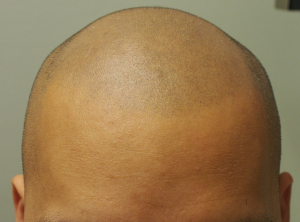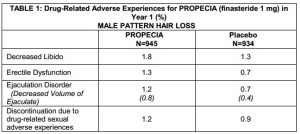This patient with frontal balding (Class 3A pattern) had surgery 4 days ago. He has black hair and white skin, making the grafts very obvious, but as I always tell my patients, keep their hair long so that they could get good camouflage for the grafts, and so that is what these photos of a fresh hair transplant show. The hair already gut pushed out a bit so it looked like the hairs were growing. Note, at 4 days, there are no scabs present and this is typical of our patients because of our special focus on keeping the blood from building up during the surgery and after the surgery in the post operative special washing instructions are followed carefully by each of our patients.
Before this was done, I stayed home all of the time. Now I can go out and even went to a few parties. I felt really good about myself.
This is the type of reaction we hear all of the time. Scalpmicropigmentation changes the lives of patients as much or even more than a hair transplant and it cost less and appears almost immediately, unlike a hair transplant that takes about 6 months to grow. Long hair or a shave head is a patient’s styling choice.
Tags: SMP, scalp micropigmentation, scalpmicropigmentation, photos of SMP
On NPR duing my morning drive this morning, a somewhat interesting study of work habits was discussed. Hedge funds are those funds which manage wealth for the very rich. It seems that for those funds which have a single manager (common), if the manager is either getting divorced or getting married, the performance of the hedge funds falls to the point where they lose money as compared with those hedge funds where the manager has either a stable marriage or is not married. That tells us that we bring our personal lives to work and our personal lives impact the work we do. One might extend that concept to every working man, doctors, dentists, accountants, contractors, carpenters, plumbers, etc… should we find out more about those people we need to do business with before committing money or our health to someone who may produce unpredictable performance?
FYI: Drs. Pak, Kim, Fargo and I are all committed to a monogamous relationship where we find great joy and are very happy, so we can safely take care of you, our patients.
“Drug-poisoning deaths involving heroin use have soared since 2000, and most of the increase occurred since 2010. From 2010 to 2013, the rate of heroin overdose deaths increased 163%. From 2010 to 2013, the rate of heroin overdose deaths increased 163% for men, from a rate of 1.6/100,000 population in 2010 to 4.2 in 2013. For women, the death rate increased by 200%, from 0.4/100,000 in 2010 to 1.2/100,000 in 2013. From 2000 to 2010, however, the rate of increase was much slower, with the death rate increasing from 1.1 to 1.6 for men and from 0.2 to 0.4 for women.” These statistics were reported by the National Center for Health Statistics.
Look at your children and know what they are doing. Most of these deaths are in young people, so the statistics are misleading when you think about children. These deaths are someone’s children and hopefully they will never be yours.
This week I met a 22 year old balding young man names Alex. His father and mother joined him and were very supportive. He is well on the way to a Class 7 pattern (just a rim of hair around the back and sides of his head). The remaining hair on his head looked like a more advanced balding pattern than Prince William has now but the entire frontal area has not a singe hair on it. His hair supply was slightly under average for a Caucasian and his hair was fine and dark brown. His father told me that this is exactly where his hair loss pattern was when he was 22 years old. It was clear that Alex would develop his father’s hair loss pattern. I measured his hair density which was lower than average. He could never have had a full head of hair with a hair transplant contrary to other doctor consultation he had before he visited me. The previous doctor told me that hair transplants were a reasonable option and he could transplant his entire head.
Fine hair is not the best hair for hair transplants on a very bald man if the goals are to get a full ‘appearing’ head of hair. Frontal hair coverage with a bald crown is a reasonable option, but Alex did not like that look because at 22, nothing but a full head of hair was an option. He also did not like the idea of going on the drug Propecia. Doctor who promise or even suggest that a full appearing head of hair is a possibility are not honest doctors and young men like Alex could become victims of such physician behavior. Alex was smart to bring his parents with him, something he didn’t do with his previous physician consultation. Alex and his parents listened carefully to what I had to say, and we quickly ruled out hair transplantation. He did, however, quickly embrace the scalp micropigmentation option which would give him a quick, far less expensive alternative that would give him a youthful look, just like his age would requires. I told him not to rush in this important decision. I suggested that he come to one of our Open House events where he could meet others who had scalp micropigmentation. At 22 years old, he must recognize that this is a decision for the rest of his life and a good decision today, is a good decision tomorrow. He liked that approach.
“In the study, Finnish researchers in the journal: Medicine & Science in Sports & Exercise, looked at 10 pairs of identical twin men. Each set of twins was in their mid-30s, and each had been brought up in the same household. Since they were identical, they also shared the same DNA. The only difference was that though they had maintained the same level of physical activity for most of their lives, one twin had cut way back on exercising recently when the study was done due to work or family pressure; on average, the active twin worked out at least twice a week, while the less active twin exercised less than twice a week. The research team put each twin through a host of medical tests to get a sense of their overall health.
The results revealed big differences between each twin. While the more active twins had lower body fat percentage (20.7 versus 24), better endurance levels, and normal insulin sensitivity, the sedentary twins had about seven more pounds of body fat, worse endurance, and insulin sensitivity that showed signs of early metabolic disease. Not only were their bodies different; their brains diverged as well. The athletic twins had more gray matter (the information processing part of the brain), particularly in areas that controlled balance and motor function.
This should motivate our readers to, at the least, exercise at three times a week. More exercise is, of course, better. Generally, it is believed, that 30 minutes of fast walking three times per week should do it for most people.
More and more men are taking supplemental testosterone to increase their feeling of youth and augment their sex drive. The concern for some time has been concerns about safety asking questions related to the risks of increased stroke or heart attacks in those men taking supplemental testosterone. For men who have a low serum testosterone, the indications are clearly present but, but for men who have not tested their serum testosterone and just want to take the drug (this is common), now there is new data from “two studies — one observational, the other a meta-analysis —just presented at the American College of Cardiology (ACC) 2015 Scientific Sessions that also showed no increased cardiovascular risk (heart attacks) among testosterone users”. For those men reading this, it may allay fears if this is a consideration, but still each man considering this should clear taking this hormone with his doctor.
I belong to a group of doctors (about 50 of them) who share information with each other about various hair related subjects. The Doctors Asked If Anyone Has Experience With Cold Therapy For Cancer Chemotherapy?
I have had two patients who used Cold Caps(see: https://baldingblog.com/?s=cold+cap&x=0&y=0) on my referrals. One was a breast cancer patient and the other was a long cancer patient. They both told me details about the experience which were identical:
Their doctors did not like nor endorse the technology and had no awareness of it prior to them doing it They did get some help from the chemo-staffs of their respective hospital facilities who were amazed at the technology It takes a dedicated partner to work with the patient as Dry Ice must be used and fresh supplies must be brought in with each treatment The Woman with breast cancer told me she was told that she was one of the only patients who did not lose hair hair (maybe 20% hair loss at most) The Man with Lung Cancer was a post hair transplant patient (3 procedures and loved his hair and could not imagine losing it), lost about 20% of his transplants with the treatment Lesson here: Recommend it to everyone. A great technology
A recent paper published in “Perspectives on Psychological Science” indicates that people who spend less time alone and are less socially isolated might live longer and this has been found to hold in all ages of people. The study was done at Brigham Young University analyzing 3 million participants from a variety of health groups. The metrics included socioeconomic status, age, gender, and pre-existing health conditions and the study suggests that a lack of social connections presents an added risk. People with relationships had showed greater health.
Specifically, “the mortality risk is increased by 29 per cent for socially isolated individuals and by 26 per cent for lonely people. Individuals living alone have a 32 per cent higher risk of dying prematurely.” When one adds excessive drinking and smoking to the mix, the numbers may be worse. “In essence, the study is saying the more positive psychology we have in our world, the better we’re able to function not just emotionally but physically,” said Tim Smith, co-author of the study.
We see in our hair restoration practice, men who lose their mates. Many feel lost and some seek hair transplants to get their hair back with an anticipation of dating again, We see this with great frequency as men want to look more desirable, and appear certainly younger. Adding hair to a balding head, makes this happen. I distinctly remember three patients; one a 68 years old, who sat with his dying wife for 4 years as she eventually succumbed to breast cancer. He rarely socialized while she was dying. When she died he visited me and told me how difficult life was during those 4 years, but he loved her a great deal and appreciated her though the end. He was missing the hair in the front of his head and got, in just one session, terrific glistening silver hair. Once the hair grew out, he went on a cruise by himself and met a beautiful 29 year old Japanese woman and by the end of the cruise they decided to marry. He came to visit me two years later to introduce her to me. His smile was radiant. He told me that being alone, just was not for him. The second man was 86, and he lost his wife and thought he looked too old, so he got a hair transplant with great results in just one session. It did not take him long to find a new wife. At 86, there were more single, available women than men by a long shot so the hunt did not take long. I think that the women hunted him out. The third patient was 55, his wife left him and he refused to date until he got a hair transplant. After just one session, he came back and told me that dating was great. He met many women on the internet and loved the attention he was getting, but he did not marry again, at least not in the first year that his hair grew out. Maybe he could not find ‘Miss Right’.
In conclusion: Hair makes a man feel more confident, younger and more able to tackle the world of ‘available women’. It also has a major impact on careers. Many Hollywood celebrities that I worked on before they became famous, developed the confidence in themselves that boosted their careers. They often felt my contribution to their ‘look’ was one of the main reasons they made it professionally. From the article referenced above, it appears that maybe hair transplanted patients will live longer, who knows. Life’s value, a man’s confidence and maybe life’s length are related.
Tags: longer life, hair transplant, hairloss, hair loss, social isolation, confidence, marriage
Early cancer detection is terrific if you have an aggressive cancer that can kill you, such as lung, bowel or breast cancer. But there are cancers that are present in your body (everyone has them) that may never grow into aggressive cancers. We know this because, for example, most men over the age of 50, will have a cancer in their prostate that do not show up on any testing and would only show up on an autopsy if they should die and have one. Even when the cancer test used to detect the ‘prostate specific antigen’ (PSA is detected as abnormally high, many of these men who previously would have radical surgery for it, today are told not to do it because the complications of the surgery, radiation or other treatments out way the risks of disease progression in most men. Even breast cancer is present in many women with what we call ‘cancer in-situ’ which means that these cancers would show up on a biopsy (if it could be found) or on an autopsy (if a person had it as an incidental finding on death). We are now developing better and better tests to pick up cancer, but are we going to over-react to these ‘pick-ups’?
Websites that market personalized cancer care early often overemphasize their stated benefits and downplay their limitations and certainly don’t focus upon the risks of treatment for very early cancers ‘in-situ’. Genetic tests whose value for guiding cancer treatment have not been shown to be clinically useful in many situation. Should everyone get a complete copy of their DNA and have it analyzied for cancer potential genes that they may harbor? Finding a cancer and suggesting an aggressive action may be harmful because it may have an unproven benefit.
“Internet marketing of cancer-related gene tests is unregulated so there is wide variation in how these services are presented, posing a challenge for consumers and their physicians, notes Stacy Gray, M.D., a medical oncologist and investigator at the Dana-Farber Center for Outcome and Policy Research and first author of the paper that analyzes 55 websites marketing the services. The study found that “in general, the benefits of these personalized cancer products are reported much more frequently than are the limitations,” continued Dr. Gray. In addition, 88% of the websites offered one or more “nonstandard” tests that lacked evidence of clear clinical utility in routine oncology practice.
A friend of mine, called me and told me that her Chest X-ray and a follow-up CAT scan showed a nodule in her lung that would be a cancer. One doctor told her to come back in 3 months and repeat the CAT scan, so she did and it was still there. She does not sleep at night worrying about it. She can address it with a surgery. IF the nodule is under 1cm, in the outer part of the lung and she has surgery and they find a cancer, she has an 80% risk of cure. If she waits, and she has a cancer and it grows, then her risk of cure goes down to under 30%. IF she has a surgery and does not have cancer, then she underwent an unnecessary surgery that she can ill afford.
As President Obama’s personalized medicine initiative rolls out, more and more information about potentials for cancer will unfold in us all. How do we respond if we know that we have a ‘cancer in-situ’? Do we demand a radical treatment such as surgery for something that may never develop to a dangerous level? Do we stand-by and wait, missing those cancers that are aggressive and can kill us? There is no clear answer to these questions, but the public generally does not understand that this is not an easy process to analyze.
Tags: cancer screening, cancer in-situ, risks of early cancer detection, complications
I am concerned about shock loss from having a hair transplant. A few years ago, I had taken Propecia for my hair loss and got Erectile Dysfunction when I as 35 years old, so I stopped taking it. I stayed on the drug less than a month and could not tolerate it. My hair loss continued as my doctor told me it would. I am now 48 years old. I want to have a hair transplant so what do you recommend that I do?
My answer is always to think worst case. Not everyone that has a hair transplant gets shock hair loss, but the risks are there and the drug finasteride (Propecia) is a great drug that usually prevents this complication. These are my general rules that I tell patients, but reading this list is not a substitute for checking with your doctor first:
1- For those under 30, I recommend it 100% of the time
2- For those between 30-35, I generally strongly recommend it.
3- For those between 35-40, I recommend it most of the time if this is their first hair transplant procedure
4- For those between 40-50, I do not insist on if if they had no previous procedure but generally recommend that they take if for up to a year
5- For those over 50, I tell them about it, but do not feel strongly about if it they are concerned about using the drug
If the patient has had a previous hair transplant in the past 5 years, I do not feel strongly that it is important to be on the medication if the patient does has hesitation on taking the drug. Usually the greatest risk of shock loss occurs after the first hair transplant as it creates shock to the hair and it is common in men under the age of 30 who are not on the drug finasteride.
Tags: propecia, finasteride, shock loss, hair transplant, hairloss, hair loss, shedding, dosage
I was reviewing some old video and saw my patient ‘Joe’ and then remembered a unique event that happened to him, He had some old ‘ugly’ hair transplant plugs and wanted to have me fix him up. So, like many patient who came before him, he presented for the surgery at 7am that morning. He was sedated with our usual cocktail and we left the room for just a few minutes while the medications were taking effect. He was draped for the surgery, with white surgical drapes around his neck. He had a surgical scrub top on, something we always put on the patient for the surgery. Not realizing his sensitivity to the medications or the rapidity of onset in his particular situation (5 minutes), while we went out of the room for just about 2 minutes, he left the operating room and walked out of the office. When I came back to the operating room, I saw the patient was gone. My staff looked all over our facility for the patient, he was clearly not there. Then I heard horns honking outside of the building. I look out the window, and saw an amazing sight. Joe, with his surgical garb on, was in the middle of the busy street directing traffic and made a mess of doing that. I panicked. I went down the three flights of stairs, out the front door of the building and crossed to the center of the street, took Joe by the arm and walked him slowly back to surgery. Everything went well, of course. All he got was 10mgs of Valium and that seemed to trigger this euphoric state. What I learned was to never leave the patient unattended until I discharge the patient from surgery and the medications wear off. I never forgot the ‘Joe’ experience.
Artificial Heart: The SynCardia artificial heart has already been used in 1250 patients awaiting a heart transplant. The FDA just gave SynCardia the green light to study whether the device could be a permanent solution in people for whom transplant isn’t an option. This is a very interesting breakthrough as I patented a type of artificial heart in 1967 and worked in the heart field for a number of years developing about 11 devices, one of which made it into commercial use ‘The Intra-aortic balloon Pump’ which is now in every coronary care unit in the world. Now a similar device which is implanted into patients “Left ventricular assist devices (LVADs) are becoming an increasingly viable alternative therapy for heart failure, either as a bridge to heart transplantation (BTT) or destination therapy (DT). The LAVD has become increasingly popular in recent years, in the face of a donor organ shortage and a rise in elderly patients ineligible for heart transplants. For these patients in particular, device durability is a key contributor to survival, morbidity, and quality of life”.
3-D Printing: of a heart is on the horizon, possibly in 5-10 years. A skeleton of collegian is laid down and then fat cells containing stem cells creates myocardial cells which fit into the shape of the skeleton created by the 3-D printing system. This was shown on CNN’s this past Sunday morning. Imagine, getting a new heart when the old one just wears out.
3-D Printing: of cartilage that can be used to replace the meniscus of the knee. This is one of the most common injuries occurring from sports, running, skiing and almost any injury of a knee joint. Now, these meniscus are removed and in almost all situations, these injuries lead to degenerative joint disease and crippling arthritis in many people.
Artificial limbs: are starting to work directly from the brain with thought propulsion activating the limb for walking or hand movements. This will be miraculous for Vets who have lost limbs or for those who have become paralyzed from almost any cause. Christopher Reeves would be smiling at these advances.
A Hand That Can Feel: a European Union effort to develop advanced prosthetic hands, has created one of the world’s most advanced artificial hands—one that can feel objects. When recipients grasp an object, hand sensors that are linked with nerves in the upper arm allow them to tell what it is. It will still take a few years to make it to market.
Retinal Implants: “About 100 people worldwide have now received the Argus® II retinal prosthesis system. This “bionic eye” uses a tiny camera mounted on a pair of glasses that sends images to a retinal implant via a small conductor. The device does not restore sight completely, but it does allow patients who have lost their vision to make out shapes and distinguish between light and dark areas”.
I have a question regarding hair loss patterns in siblings. Hair loss is frequent on my fathers side of the family (it is almost nonexistent in my mothers side). My father and uncle were both NW 3 around age 35, but they are NW 6 now. My brother on the other hand had a thinning 3V pattern at the age of 23, and is slick bald NW 6 at 30.
I have noticed a similar thinning pattern in myself when I was 23, and was wondering if I was going to follow the exact same hair loss pattern of my brother? I wanted to find out if there was any chance of me following a different hair loss pattern, seeing as my brother got from NW3 to Nw6 in almost half a decade, the rapid progression of his hair loss has been an issue of constant worry for me.
Seeing as we started thinning in the same pattern at around the same age, do you think I will follow the same route (with the same balding speed)? I have seen a few doctors regarding the issue but I believe your experience in the practice could give me a more accurate opinion.
I did use propecia and minoxidil for 2 years which has given me amazing results, but I need to quit propecia due to side effects.
How could I possibly provide a more accurate opinion than the many doctors who has actually examined you?
Anything is possible I suppose, but the main issue probably has more to do with your fear and insecurity than the actual hair loss.
I always discuss the value of a physical exam and if you are looking for a diagnosis of your hair loss issue, you need to see a doctor in person.
If you are looking for for a psychological support, you should also seek another type of doctor. I don’t mean to sound dismissive but searching for your answer on the Internet will cause more anxiety and confusion.
Tags: twins, hair loss, propecia, finasteride, hairloss
My grandfather is currently taking finasteride for prostate reasons. Even though it is the 5mg pill, I couldn’t help but notice that sexual side effects such as ‘impotence’ and ‘abnormal ejaculation’ were listed under ‘Common’. Not uncommon, not rare, but common! That being said, how ‘common’ is common? Are side effects in general rare, but sexual dysfunction is the most persistent of the side effects? When you quote a 2% chance of being subjected to sexual side effects, of what number is that 2% drawn from? Are sexual side effects rarer in
Propecia because of its smaller (1mg) dose?
Most of the studies on 1-2% sexual dysfunction is derived from the Prosar (finasteride 5mg dose). Taking a smaller dose should give you less side effect but the reported side effect is still around 1-2%.
This is taken directly from the MERCK website Propecia insert:
“In three controlled clinical trials for PROPECIA of 12-month duration, 1.4% of patients taking PROPECIA (n=945) were discontinued due to adverse experiences that were considered to be possibly, probably or definitely drug-related (1.6% for placebo; n=934). Clinical adverse experiences that were reported as possibly, probably or definitely drug-related in ?1% of patients treated with PROPECIA or placebo are presented in Table 1.”


